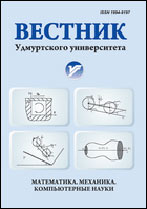|
MATHEMATICS
On two-frequency quasi-periodic perturbations of systems close to two-dimensional Hamiltonian ones with a double limit cycle
O. S. Kostromina
Department of Differential Equations, Mathematical and Numerical Analysis, Lobachevsky State University of Nizhny Novgorod, pr. Gagarina, 23, Nizhny Novgorod, 603950, Russia
Abstract:
The problem of the effect of two-frequency quasi-periodic perturbations on systems close to arbitrary nonlinear two-dimensional Hamiltonian ones is studied in the case when the corresponding perturbed autonomous systems have a double limit cycle. Its solution is important both for the theory of synchronization of nonlinear oscillations and for the theory of bifurcations of dynamical systems. In the case of commensurability of the natural frequency of the unperturbed system with frequencies of quasi-periodic perturbation, resonance occurs. Averaged systems are derived that make it possible to ascertain the structure of the resonance zone, that is, to describe the behavior of solutions in the neighborhood of individual resonance levels. The study of these systems allows determining possible bifurcations arising when the resonance level deviates from the level of the unperturbed system, which generates a double limit cycle in a perturbed autonomous system. The theoretical results obtained are applied in the study of a two-frequency quasi-periodic perturbed pendulum-type equation and are illustrated by numerical computations.
Keywords:
quasi-periodic perturbations, double limit cycle, resonances, averaged systems.
Received: 25.10.2020
Citation:
O. S. Kostromina, “On two-frequency quasi-periodic perturbations of systems close to two-dimensional Hamiltonian ones with a double limit cycle”, Vestn. Udmurtsk. Univ. Mat. Mekh. Komp. Nauki, 31:1 (2021), 35–49
Linking options:
https://www.mathnet.ru/eng/vuu753 https://www.mathnet.ru/eng/vuu/v31/i1/p35
|

| Statistics & downloads: |
| Abstract page: | 191 | | Full-text PDF : | 109 | | References: | 27 |
|




 Contact us:
Contact us: Terms of Use
Terms of Use
 Registration to the website
Registration to the website Logotypes
Logotypes








 Citation in format
Citation in format 